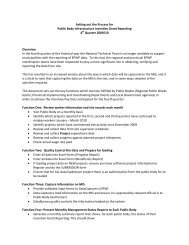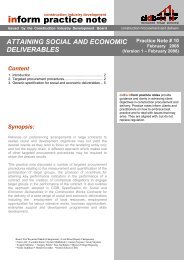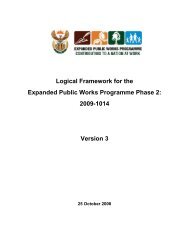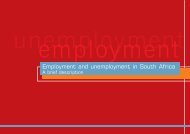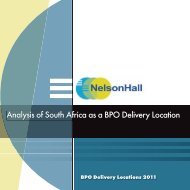Evaluation of the Monyetla Work Readiness ... - Business Trust
Evaluation of the Monyetla Work Readiness ... - Business Trust
Evaluation of the Monyetla Work Readiness ... - Business Trust
You also want an ePaper? Increase the reach of your titles
YUMPU automatically turns print PDFs into web optimized ePapers that Google loves.
• <strong>the</strong> <strong>Business</strong> <strong>Trust</strong> project <strong>of</strong>fice’s commitment to ensuring <strong>the</strong> project’s success througheffective communication and <strong>the</strong> alignment <strong>of</strong> <strong>the</strong> project to real needs in <strong>the</strong> sector.Project drawbacks communicated emanated from <strong>the</strong> following;• Eighty seven percent (87%) <strong>of</strong> employers complained about <strong>the</strong> excessive amount <strong>of</strong>paperwork required by <strong>the</strong> project <strong>of</strong>fice and how this distracted from priority projectinitiatives. They felt that <strong>the</strong> project <strong>of</strong>fice should in future resort to electronic forms,especially when it came to completing learner agreements.• Ano<strong>the</strong>r issue raised by 59% <strong>of</strong> participants was that learner stipends were very low and infive participating consortia had to be subsidised by host employers.4.6 <strong>Evaluation</strong> <strong>of</strong> <strong>the</strong> Funding Model4.6.1 The Project BudgetThe Project budget consisted <strong>of</strong> two components: The first component was <strong>the</strong> learnership grantamounting to R17,1 million and intended to fund <strong>the</strong> training <strong>of</strong> 1,000 learners. This grant was madeavailable by <strong>the</strong> DoL and channeled through <strong>the</strong> National Skills Fund to <strong>the</strong> <strong>Business</strong> <strong>Trust</strong>.Originally <strong>the</strong> total amount included VAT at 14% subjected to all line items including stipends. It waslater realised that VAT was not enforceable on <strong>the</strong> stipend line item, <strong>the</strong>reby yielding funding for anadditional 99 places. A ruling by SARS not to enforce VAT on <strong>the</strong> entire grant yielded ano<strong>the</strong>r 154places. A total <strong>of</strong> 253 places were added to <strong>the</strong> pool at a net cost <strong>of</strong> R13,650 VAT per learner at <strong>the</strong>original budgeted total <strong>of</strong> R17.1million.The second component <strong>of</strong> <strong>the</strong> programme was <strong>the</strong> cost <strong>of</strong> project management, publicity andevaluation. This came to a total cost <strong>of</strong> R3,025 million and is broken down per line item in Table 13.Table 13: Project Management BudgetBudget ItemCostsPublicity (video and brochure) R150,000Project ManagementR2,050,000<strong>Evaluation</strong> R825,000Total CostR3,025,000Evidence shows that a BPO&O work readiness programme tailored to ensure 70% employmentrates can be successfully implemented with a budget <strong>of</strong> R13,650 per learner.4.6.2 Payment <strong>of</strong> Learner StipendsFifty-nine percent (59%) <strong>of</strong> <strong>the</strong> consortium signatory lead members indicted that learner stipendswere too low and could have been increased by a minimum <strong>of</strong> R500 per learner, especiallyconsidering that learnerships were targeted at people from poor communities and <strong>the</strong> mostimpoverished tended to be located far from business hubs making transport costs prohibitive. Five <strong>of</strong><strong>the</strong> host employers had stepped in to increase <strong>the</strong> learner stipend, with two <strong>of</strong> <strong>the</strong>m increasing it toR2,500, and three increasing it to R1,500.The majority <strong>of</strong> training providers who were tasked with disbursing learner stipends stated that<strong>the</strong>se were paid on time. Learner stipends were considered a priority again because most <strong>of</strong> <strong>the</strong>learners came from poor communities and <strong>the</strong> learnership would have been characterised by highabsenteeism had stipends not been paid on time.Only one consortium indicated that stipend payments had been a challenge at <strong>the</strong> beginning <strong>of</strong> <strong>the</strong>programme, with <strong>the</strong> lead signatory member having to step in to cover stipend payments because46



